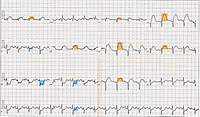
Photo from wikipedia
Cardiovascular diseases are the leading cause of death, globally. Stroke and heart attacks account for more than 80% of cardiovascular disease-related deaths. To prevent patient mismanagement and potentially save lives,… Click to show full abstract
Cardiovascular diseases are the leading cause of death, globally. Stroke and heart attacks account for more than 80% of cardiovascular disease-related deaths. To prevent patient mismanagement and potentially save lives, effective screening at an early stage is needed. Diagnosis is typically made using an electrocardiogram (ECG) analysis. However, ECG recordings are often corrupted by different types of noise, degrading the quality of the recording and making diagnosis more difficult. This paper reviews research on automatic ECG quality assessment techniques used in studies published from 2012–2022. The CinC11 Dataset is most often used for training and testing algorithms. Only one study tested its algorithm on people in real-time, but it did not specify the demographic data of the subjects. Most of the reviewed papers evaluated the quality of the ECG recordings per single lead. The accuracy of the algorithms reviewed in this paper range from 85.75% to 97.15%. More clarity on the research methods used is needed to improve the quality of automatic ECG quality assessment techniques and implement them in a clinical setting. This paper discusses the possible shortcomings in current research and provides recommendations on how to advance the field of automatic ECG quality assessment.
Journal Title: Diagnostics
Year Published: 2022
Link to full text (if available)
Share on Social Media: Sign Up to like & get
recommendations!